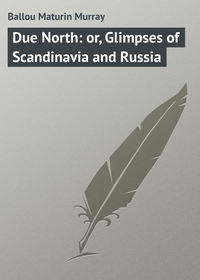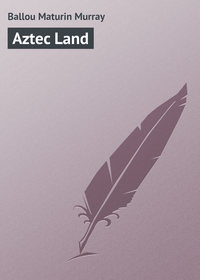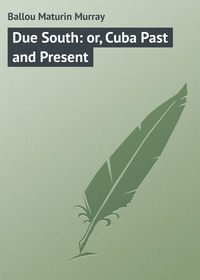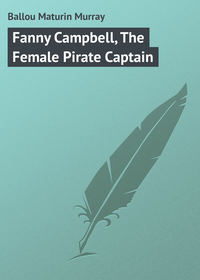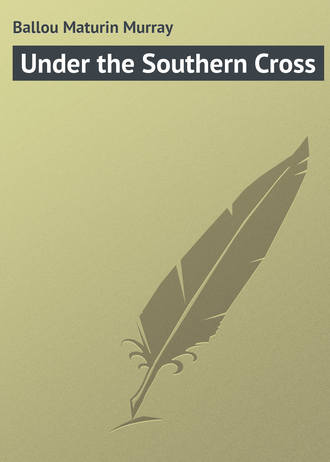 полная версия
полная версияUnder the Southern Cross

Under the Southern Cross Or Travels in Australia, Tasmania, New Zealand, Samoa, and Other Pacific Islands
PREFACE
Dr. Johnson is reported to have said that the best way to travel is to sit by one's own fireside and read how others have done it; but though this may be the safest mode it certainly is not the pleasantest. This any travelled writer knows; and he also knows that could he succeed in adequately inspiring the reader with his accounts of the delights of foreign experiences, especially those of the grand, beautiful, and marvellous exhibitions of Nature, he would surely induce him to add to his own enjoyment by similar personal experiences. That there is a degree of pleasure in recording these observations we freely confess; but that one constantly feels how inadequate is language to convey a realizing sense of what is actually enjoyed in travel we must as freely admit. Madame Swetchine was more sarcastic than truthful when she pronounced travel to be the frivolous part of serious lives, and the serious part of frivolous ones. To an observant person nothing can be more instructive than travel; in fact it may be said to be the only royal road to learning. Travel is a magician, – it both enchants and disenchants; since while it delights the eye, it often proves the winding-sheet of many cherished illusions. There is always some bitter to be tasted with every sweet; but even the bee which finds a thorn on every rose comes home laden with honey.
M. M. B.Boston, January, 1888.
CHAPTER I
Journey across the American Continent. – The Giant City of the West. – A Chinese Community. – Embarking for a Long Sea-voyage. – About Ocean Birds. – Navigating the Pacific. – Peculiarities of Life at Sea. – Curiosities of the Deep. – Ambergris. – City of Honolulu. – An Island Paradise. – Early Paganism at Hawaii. – Wholesale Human Sacrifices. – Royalty at the Race-course. – Not a Kingly Monarch.
When the author resolved upon a journey to the Antipodes he was in London, just returned from Norway, Sweden, and Russia, and contemplated reaching the far-away countries of Australia and New Zealand by going due east through the Mediterranean, the Suez Canal, the Red Sea, and then crossing the Indian Ocean. But this is not the nearest route to Oceania. The English monthly mail for that part of the world is regularly forwarded from Liverpool to Boston or New York, thence across the continent of America, and by steamboat from San Francisco. These mail steamers touch at the Sandwich Islands, after which the course lies southwest into the island-dotted latitudes of the widespread South Pacific. Auckland, in New Zealand, is reached by this route in thirty-seven days from London; and Sydney, in Australia, five days later, – the two great English colonies being separated by over a thousand miles of unbroken ocean. The latter route was adopted by the writer of these pages as being both more comfortable and more expeditious. Having already experienced the sirocco-like heat of the Red Sea throughout its whole length, from Adin to Suez, the prospect of a second journey in that exhausting region was anything but attractive. The Atlantic Ocean was therefore crossed to the westward, and a fair start made from much nearer home; namely, by the American Central Pacific route.
The journey by rail across our own continent was easily accomplished in one week of day-and-night travel, covering a distance of thirty-four hundred miles from Boston to San Francisco. Comfortable sleeping-cars obviate the necessity of stopping by the way for bodily rest, provided the traveller be physically strong and in good health. On a portion of the road one not only retires at his usual hour, but he also breakfasts, dines, and enjoys nearly all the domestic conveniences in the train, while it is moving at a rate varying from thirty-five to forty-five miles per hour, in such well-adjusted cars as hardly to realize that he is all the time being rapidly and surely forwarded to his destination.
The pleasing variety of scenery presented to the eyes of the watchful traveller from the car windows is extremely interesting and peculiarly American, embracing peaceful, widespread, fertile fields, valleys of exquisite verdure, foaming torrents and mountain gorges, together with Alpine ranges worthy of Switzerland. Now the route skirts the largest lakes on the face of the globe, navigated by mammoth steam ships; now follows the silvery course of some broad river, or crosses a great commercial water-way, hundreds of feet above its surface, by iron bridges skilfully hung in air. For scores of miles the road may run parallel with some busy canal crowded with heavily-laden barges, slowly making their way to market. Besides winding through mountain gorges, plains, parks, and primeval forests, one passes en route through grand and populous cities numbering half a million and more of people each, as well as through pleasant towns, thrifty villages, pioneer hamlets, and Indian reservations, where the plains are as far-reaching as the open sea, the blue of the sky overhead and the yellow buffalo-grass which carpets the earth forming the only blending colors, – until by and by a distant glimpse of the waters of the Pacific signifies that the land-journey draws near its close, and soon after the young but wonderful giant city of the West, San Francisco, is reached.
Five years had elapsed since we last visited this thriving metropolis, during which brief period whole streets of substantial houses have been erected in what was formerly a suburb of the town, and many noble architectural structures have been reared upon the long avenues previously established. In population forty thousand inhabitants have in that space of time been added to its aggregate numbers, while it is to-day growing in wealth, numbers, and political importance faster than ever before. What a panorama of living interest was afforded by its streets, alleys, and broad boulevards! How impressive to watch its cosmopolitan life, to note the exaggerated love of pleasure exhibited on all hands, the devotion of each active member of the community to money-making, the artificial manners and customs so widely prevailing, the iniquitous pursuits of the desperate and dangerous classes, and the ripe aptitude of their too willing victims! It is the solitary looker-on who sees more than the actors in the great drama of every-day life. It is "the hearing ear and the seeing eye" that enrich the memory and ripen the judgment. Is it not curious to observe how the lines of barbarism and civilization intersect along these teeming avenues?
Of our own country we do not propose to treat at length in these pages; but probably not many of our readers have visited the hidden corners of Chinatown in the metropolis of California, – a section of the city contiguous to its very centre, and yet at total variance with its every aspect. It required but a slight stretch of the imagination after passing its borders to believe oneself in Canton, Pekin, or Hong-Kong, except that the thoroughfares in the Asiatic capitals are mere alleys in width, shut in overhead and darkened by mats, while here we have broad streets after the American and European fashion, open to the sky. They are, however, lined with Chinese shops decked in all their national peculiarities exhibiting the most grotesque signs, while the windows are crowded with outlandish trash, and the whole is surrounded by an Oriental atmosphere. This section is entirely peopled by the Mongolians, and by such poor, fallen, abandoned men and women of other nationalities as seek among these surroundings to hide themselves from the shame and penalty of their crimes. There are but few native Chinese women here, and those that are seen have been smuggled in, it being the rule that none of them shall be landed in this country.
The Chinaman appears thoroughly at home here, and revels in his native dress, – pigtail, odd shoes, and silk attire, – even though he may adopt the American style while working as a stevedore on the wharves, or while engaged in various avocations about the other parts of the city. Here without the least attempt at disguise all the many vices of the race are freely indulged in, especially as regards sensuality, opium-smoking, and gambling. A Chinaman rarely touches spirituous liquors, so that there is no drunkenness to be seen in the district, but only that insensibility which is the effect of indulgence in opium. The thirty thousand Asiatics who live in Chinatown are packed together at night like dried herring in a box. Twenty of them often sleep in the same small room, lying upon the floor, without even an apology for a bed. Here they cook and eat mysterious dishes after the custom of their race, amid smells and filth which no American or European stomach could endure.
A couple of hours sufficed to give us all the personal experience of this locality we had the least wish to acquire, though our official guide of the police force proposed to introduce us to other peculiar sights and into deeper cellars, – places usually hidden from the curious eyes of the general public. The vile practices, indecent and gross exhibitions, which are indulged in by these Mongolians, no respectable paper would publish in detail. In short, Chinatown is the repository of vice of the most brutal and disgusting character, affording the fullest entertainment for the low tastes of the most depraved. Finding that this pandering to the curiosity of a certain class of whites brings them in money, the Chinamen give them all the grossness they are willing to pay for.
The reader, however, must not entertain a wrong idea with regard to Chinatown, since in the midst of all this squalor, dirt, immorality, and wickedness, there are some of this race living here who keep themselves untainted by the objectionable associations that surround them. They are the exceptions, to be sure. We were told of several Chinese gentlemen, for instance, who have amassed large fortunes by legitimate trade, within the last ten or fifteen years, – men who, as reliable and honorable merchants, stand high among the commercial people of San Francisco. Three names were given us by a gentleman who was well informed in the matter, of Asiatics who were each worth over a million dollars. To these were added the names of two who are worth over two millions. These men will not return to China, because the property tax is so high there. Like many of our own citizens, these Chinese find their great satisfaction in accumulating wealth, and so go on adding daily to their possessions. We have said that there are thirty thousand Chinese in this district, but we were officially informed that forty thousand would be much nearer the true aggregate.
The impression prevails that the open immigration of this race has ceased at San Francisco, but the arrival of several hundreds by steamer the day before we visited their miserable quarter of the town, was duly announced in the papers. These came by the way of Japan. A sickening odor adheres to one's clothing for hours after returning from the Asiatic section of San Francisco, – a flavor of musk, opium, stale tobacco, and sandal-wood, the latter being freely burned as an incense before the Chinese gods; for amid all his filth and vileness, John does not forget scrupulously to fulfil the conventional requirements of his idolatrous faith.
After a few days devoted to renewing acquaintance with the familiar localities of the city, passage was taken on board the Union Steamship Company's mail-packet "Zealandia" bound for Australia. Once before the Golden Gate, as the entrance into the harbor of San Francisco is called, had been passed by the author when bound upon a twenty days' sea-voyage. Japan then formed the objective point, the route being a northerly one; but the "Zealandia" was bound for the tropics and the far southern sea, – that vast region forming the largest expanse of ocean in the world and containing fully one half of its water surface. The Pacific measures nine thousand miles from north to south, and is ten thousand miles broad between Quinto, South America, and the Moluccas, or Spice Islands; while at the extreme north, where Behring Strait divides the continents of Asia and America, it is but about forty miles in width, and in clear weather one can distinctly see the shore of Asia from that of our own continent.
The harbor of San Francisco presented much the same busy scene which so impressed us five years before; it was full of commercial activity and the occupations incident to various forms of maritime life. The noise of steam-whistles from the ferry-boats, the hoarse signals from ocean-going vessels starting on long voyages, and the boatswain's shrill whistle were half deafening as they mingled in direst discord. Big white sea-gulls in myriads flew fearlessly in and out among the shipping, uttering defiant screams, or floated like corks upon the water alongside of the ship. In no other part of the world are there so many snow-white sea-gulls to be seen as frequent this spacious and charming bay. They are large, graceful, dignified birds, and are never molested, being looked upon as picturesque ornaments to the harbor; besides which they are the most active sort of scavengers in removing the floating carrion and the débris thrown from the wharves and the cook's galley. The gulls one sees off the coast of Norway and among the Loffoden Islands are thousands in number, but they are not nearly so large as are these bird-monarchs of the Pacific. Their rank, fishy flavor renders them unfit for the table, though the Chinamen about the wharves secretly snare and eat them. Their breeding-places are not known, but they must be hundreds of miles away on unfrequented rocks and reefs. Distance, however, is of little account to these buoyant navigators of the atmosphere.
One of the ship's officers told us of a sea-gull which was caught within the last year just off the Golden Gate, and detained for a brief period on board a steamship bound for Japan. A short piece of red tape was securely tied to one of its legs, after which the bird was released. This identical gull followed the ship across the Pacific into the harbor of Yokohama, – a distance of over four thousand miles. Until this experiment was tried, it had been doubted whether the same individual birds continue with a ship on a long voyage as they seem to do. "You will see the albatross as we get down south," continued the officer, "a bird worth watching, the largest of the gull family, frequently measuring across its outspread wings twelve feet from tip to tip." We resolved to be on the lookout for this king-bird, though rather doubting the mammoth proportions attributed to him.
By turning to a map of the Western Hemisphere it will be found that the Sandwich Islands are located far up in the northeastern part of the Pacific Ocean, whence a vessel laying her course for New Zealand steers south by west through a long tract of ocean, seemingly so full of islands that the inexperienced are apt to wonder how she can hold such a course and not run foul of some of the Polynesian groups. But so vast are the distances in Oceania, so mathematically exact are the rules of navigation, so well known are the prevailing winds and currents, that the passengers of a steamship may make the voyage and not sight even a headland between Honolulu and Auckland, – a distance of more than four thousand miles. This is the course we pursued, first steering for the Hawaiian group, and thence for the north headlands of New Zealand, via Tutuila, of the Samoan Islands.
It was Magellan, the Portuguese navigator, who first discovered this great ocean, sailing through the strait which bears his name. In the month of November, 1520, he finally came into the waters of the new sea upon which he was the first to sail, and which he named Mar Pacifico. It may have been "pacific" in his day, or may have seemed so to him after experiencing some rough weather on the other side of the continent of America, but we have seen it more turbulent than the Atlantic, especially where it approaches the Antarctic circle. Magellan did not long survive to enjoy the fame and profit of his discovery, as about a twelvemonth later he was killed in an unfortunate skirmish with the savages of some of the Pacific islands. He is often compared with his great contemporary Columbus, whose experience in the West Indies was undoubtedly the incentive for Magellan on his voyages of discovery.
Sea-life is conducive to idleness, and the saline atmosphere is narcotic. Lying in his berth the voyager gazes listlessly at the yellow iron-mould on the towels, the greasy moreen curtains, the restless hanging-lamp, and the damp, begrimed carpet, while he inhales the unpleasant bilge-scented atmosphere which penetrates everything. The jerking motion of the ship shaken incessantly by the propeller, causes the letters of the printed regulations tacked upon the door to run together in unintelligible lines, until at last he grows dizzy with the ceaseless motion imparted to everything. Finally, with a sudden burst of energy the deck is reached, where there is pretty sure to be something suggestive to occupy the mind and vary the wearisome monotony. The wonderful blue of the sea by day, and its fire-like phosphorescence by night, are always interesting. The Mediterranean between Malta and Gibraltar is proverbially blue, but the Pacific seemed to us more so. At times it lay as if in a trance, a perfect calm, the ship's keel gliding as it were over a burnished metallic field, or a flood of molten sapphire. The familiar jelly-fish often appeared above the liquid depths, contracting and expanding its soft, flat body, and thus progressing through the still waters, its half-transparent form emitting opaline colors under the warm rays of the sun. The many-armed, vaulting cuttle-fish was seen now and again leaping out of the water as though pursued by some aquatic enemy, though its general habit is not to frequent the surface by daylight. Specimens of the deep-sea star-fish with its five arms of equal length were abundant. Those which we met here were of a reddish and purple color combined, but we have seen them in shallower waters of a bright orange-yellow. While exhibiting but little apparent life, the star-fish can yet be quite aggressive when pressed by hunger and in search of food, having, as naturalists tell us, a mysterious way of causing the oyster to open its shell, whereupon the star-fish proceeds gradually to consume the body of the bivalve.
One frail, small rover of the quiet surface of the sea always interested us, – the tiny nautilus, with a transparent shell almost as frail as writing-paper. It was to be seen only in calm weather. If disturbed, it drew itself within its sheltering cover and sank slowly from sight. No wonder the ancient Greeks saw in its beautifully corrugated shell the graceful model of a galleon; and hence its name, derived from the Greek word which signifies a ship.
Every amusing suggestion, however trivial, is welcome, if it only serves to break the depressing monotony of the sea, – a sail, a shark, a new ocean bird, a school of porpoises. Two or three of our passengers had supplied themselves with microscopes, and they often dropped a gauze scoop-net over the ship's side, where it was permitted to trail for a few moments; then drawing it on board they amused themselves by subjecting the contents to a microscopic examination. The results were often very curious. On one occasion a short bit of floating sea-weed was thus obtained, upon which was securely woven a cluster of what looked like tiny quinces in shape, though the color was jet black. They were called sea-grapes by the sailors, but we knew them to be a cluster of fishes' eggs. They proved to be those of the cuttle-fish, and were eighteen or twenty in number.
Amiable persons exhibit their natural traits of disposition at sea in strong contrast to those who are actuated by opposite qualities, – the latter, we are sorry to say, being nearly always in the majority. Enmities and friendships are formed with equal promptness and facility; but however desirable it may be, there is no escaping the forced companionship incident to life on shipboard, where ceremony is for the time being mostly banished. Customs become established which would be considered rather outré upon land. Ennui has made more persons reckless than has despair. Those individuals are comparatively few on such occasions who have sufficient mental resource profitably to occupy their minds, and those who have nothing to do quickly tire of themselves and of all about them. If it were not for the decided breaks in the routine of each day and evening afforded by the several meals, surely suicides at sea would be frequent. One inevitable conclusion is sure to be arrived at; namely, that a long sea-voyage is an infallible remedy for over-fastidiousness and sickly sentimentality.
When we had been at sea about a week there was observed floating upon the water a pale-gray, amber-like substance; it was not abundant, but to the watchful eye seemed peculiar, and was several times apparent. This our captain declared to be ambergris, – a substance originally found in the intestines of the sperm whale, and believed to be produced there only. Science declares it to be a diseased secretion of the animal, probably induced by indigestion, – just as the pearl is a diseased secretion of the Australian and Penang oysters. Ambergris is often found floating about the shores of the Coral Sea and throughout the region known as Australasia, having been ejected by the many whales frequenting these latitudes. On the west coast of New Zealand the natives may frequently be seen searching along the shore after a heavy gale, eagerly securing more or less of the article. The "Zealandia," on her previous voyage to that of which we are now writing, brought from Auckland to San Francisco three boxes of ambergris weighing about one hundred pounds each, the three boxes being invoiced at a valuation of thirty thousand dollars. It is rarely that so much is imported into this country in a twelvemonth. When first taken from the whale it is of a soft texture, and is quite offensive to the smell; but after a brief exposure to the air it rapidly hardens, and then emits a sweet, earthy odor, and is used for the manufacture of the choicest perfumery, being nearly as important for that purpose as the more costly musk.
The peculiar currents of the sea in these special regions, its vast extent and fabulous depths, the huge monsters and the tiny creatures occupying it, the speed of the ship, her exact tonnage and the trade in which she had been engaged since she was launched on the Clyde, – all these items became of vital importance to the voyagers, but their detail would seem prosy to the general reader. It was really surprising to see how earnest intelligent people become over matters which under ordinary circumstances and on shore would not have received a moment's consideration.
The distance which we expected to accomplish was referred to daily, and was thus formulated: From San Francisco to Honolulu is twenty-one hundred miles; from Honolulu to Auckland is thirty-eight hundred miles; from Auckland to Sydney is twelve hundred and eighty miles. The ship's run was daily recorded and posted up for the general satisfaction, the result being promptly deducted from the aggregated figures as above.
It was on the eighth day of the voyage that we made the Sandwich Islands. A glance at the map will show the reader that these volcanic upheavals lie on the bosom of the North Pacific, in a slight curve, and number thirteen in all. The total area combined does not exceed sixty-five hundred square miles, seven of them being mere islets, and six only are inhabited. The largest of the group is Hawaii, situated the farthest south, being in round numbers a hundred miles long by eighty broad, and with the natives gives its name to the whole group, as they are here officially called the Hawaiian Islands, – though Captain Cook, on their first being discovered, about a hundred years ago, gave them the name of the Sandwich Islands, after the then first Lord of the English Admiralty, and by this latter name they are generally known on the maps and in geographies.
The chain of islands which form the group are but a series of volcanic peaks rising abruptly from a depth of three miles below the sea-level to as great a height above it, being, so to speak, natural chimneys from the tops of which vast internal fires in former ages have found vent.


